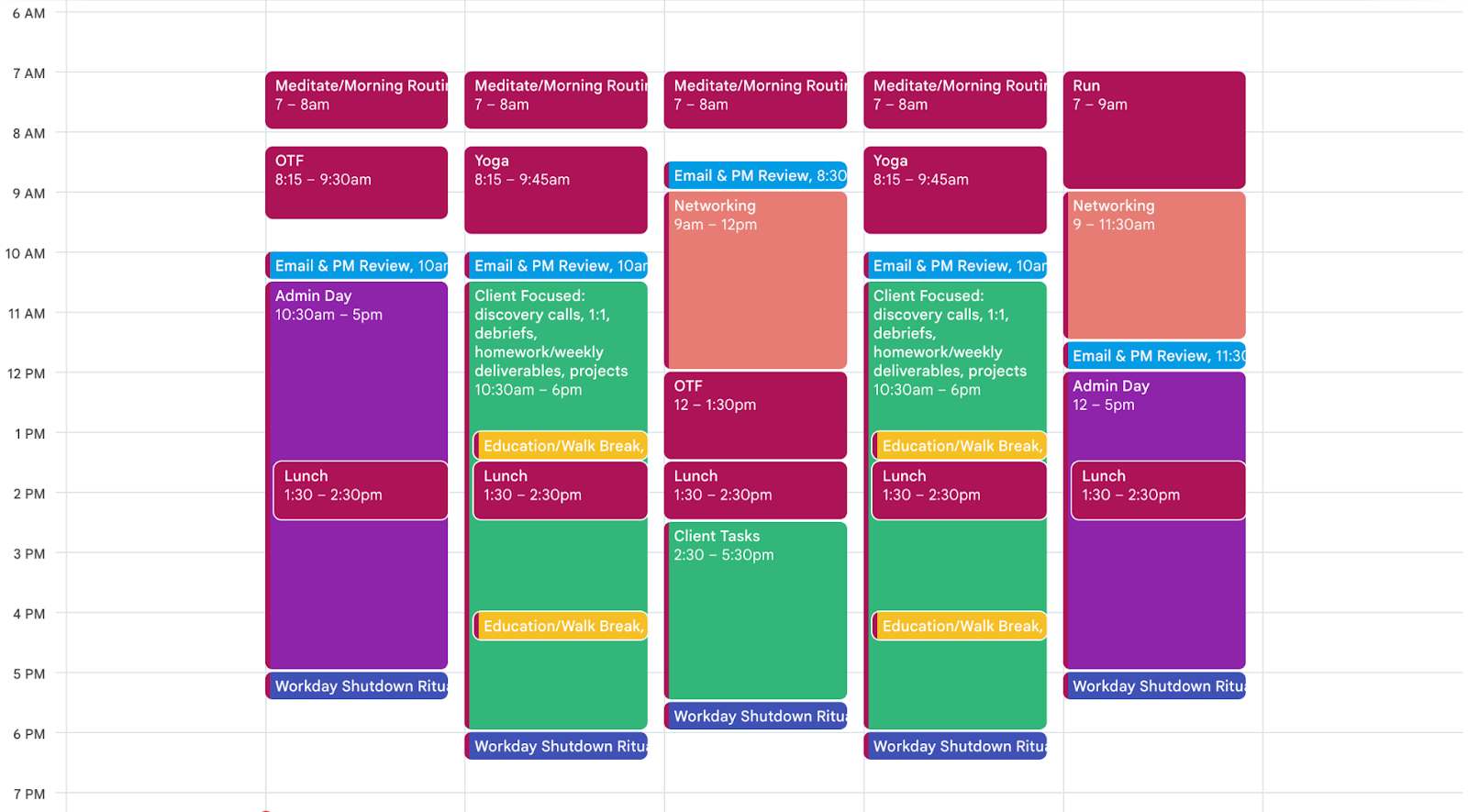November 4, 2025
Stop letting your calendar run *you*

If you own a business, you’ve probably had that “how is it already Thursday?” moment — while you’re still catching up on Monday’s to-do list.
That’s the sign it’s time to design your ideal work week.
I’m not talking about rigid schedules or overly complicated systems. I mean strategically blocking your time so you can run your business with intention — not constant reaction.
Because when you’re the one wearing all the hats as a solopreneur, time management isn’t just about productivity — it’s about sustainability.
Your calendar is more than a scheduling tool. It’s a reflection of your priorities. And if you don’t intentionally design it, everything — and everyone — else will.
Blocking your calendar helps you:

I came across this concept when I was getting Your Business Blueprint off the ground. A business owner friend of mine who runs a VA company recommended it, and honestly — at first, I hated the idea.
I thought, “There’s no way I can fit my schedule into these little boxes.”
If I only took client calls on Tuesdays, I’d lose business. If I blocked Fridays for admin, what would happen when someone needed me that day?
But here’s what I learned — it’s not about locking yourself into a rigid schedule. It’s about creating structure that helps you stay focused and protect your time. When something urgent or important comes up, you can look at your calendar and make an intentional decision: Does this fit right now?
Sometimes it’s a yes, sometimes it’s a no — but either way, you’re deciding, not reacting.
Now it’s something I teach all my clients — whether they’re brand-new business owners in my START SMART™️ Coaching and course, or early-stage solopreneurs working with me through my Operations Audit & Overhaul systems and operations packages.
At first, it usually feels a little cringy — like it’s too structured or too simple to make a difference. But once they start using it consistently, they begin to notice the shifts — less overwhelm, more focus, and a better sense of control over their time. There’s always some trial and error involved in figuring out what works best for their energy, clients, and workload, but eventually they see how much easier it is to lead their business instead of constantly reacting to it.
And I’ll be the first to admit — I’m not perfect at it either. I’m notorious for taking on too much and overfilling my calendar. Having dedicated time blocks for networking, for example, forces me to get real about what I can actually handle. I love connecting with people, but my “reality check” moment came when I realized I was scheduling seven coffee chats in a week. Spoiler: that’s not sustainable.
The same goes for client work. Do you ever look at your week and think, “Why am I seeing clients five days straight?” Then Friday hits and you realize you haven’t done your admin tasks, followed up with leads, or touched your marketing? Yeah… same. That’s why these blocks matter — they help you create space for everything your business needs to run smoothly.
There’s no one “right” way to do this. What matters is finding a system that works for your brain and your business.
Perfect for those who thrive on structure (or have teams that rely on knowing exactly when things happen).
Not so great if you have ADHD or if a single interruption can derail your whole day.
My personal favorite — and the sweet spot for most small business owners.
Instead of micromanaging your time, group tasks into larger focus blocks like:
Sometimes I add specific tasks to the description of a time block or directly to my calendar from my project management tool. Usually just two or three priority tasks in that category that need to get done — nothing more.
This one’s great if your business operates in cycles or you handle a lot of different responsibilities.
For example:
You can even dedicate one day a month to CEO work — reviewing data, goals, and upcoming launches.

Here’s the five-step framework I teach my coaching clients:
Then — and this is the part most people skip — honor it.
Treat those blocks like meetings with your most important client: your business.
Pro Tip: I like to create my “ideal work week” in a separate calendar within Google Calendar. That way, I can toggle it on and off when I’m planning out my actual week or setting new appointments. Once it’s built, I take a screenshot of just that calendar view — usually labeling the top of each column with the weekday (instead of the date shown in the screenshot) — and save the image in a folder or my project management workspace (I absolutely LOVE Monday.com for PM needs) for quick reference.
This makes it easy to compare what my actual week looks like versus what I intended it to look like.
When your week has structure, you stop reacting and start leading.
You’ll have:
You’ll start to see patterns — where you overcommit, when you procrastinate, and what actually moves the needle.
And from there, you can make decisions that help you work smarter, not harder.
Designing your ideal work week doesn’t mean everything will run perfectly — it just gives you a structure to work from.
I do this with every client — and for myself — because it makes such a difference when you can actually see your week. It’s a lot easier to be realistic about your time when it’s right in front of you.
Below is a screenshot of what my own ideal work week looks like so you can see how I break things down. It’s not fancy — just intentional. It helps me see where I have room for clients, admin, marketing, networking, and even time off.
Everyone’s setup looks different, but the point is to stop winging it week after week and give yourself a plan that supports the way you work best.

Do my days always look like this? No.
Some days I take lunch at noon, skip orange theory to catch up on something or grab coffee with a friend on a Monday morning. I go to networking events on Tuesday mornings, and yes — I’ve seen clients on Fridays. I try to stick to this layout as much as possible, but I’m also flexible enough to know that not everything will fit neatly into the shiny boxes I’ve set up.
What it gives me is pause and consideration. It reminds me to be intentional — to think before saying yes to something new or rearranging my week. It helps me plan from a big-picture view instead of just reacting to what’s coming at me day by day.
The goal isn’t to live by the calendar; it’s to have a structure that supports me. Some weeks look close to this, others don’t at all — and that’s okay. What matters is that I always have something to come back to when things start to feel off track.